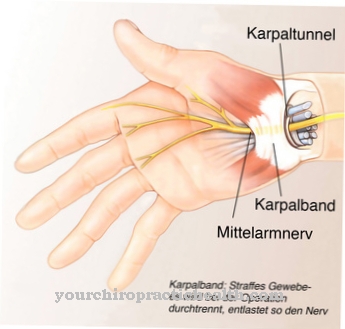At the Dumping syndrome it is an accelerated emptying of the stomach. Those affected suffer from various ailments.
What is dumping syndrome?

© Henrie - stock.adobe.com
Dumping syndrome refers to the emptying of food from the stomach into the small intestine. The term "to dump" comes from English and translates as "to plop". The symptoms are often the result of gastric surgery. Five to ten percent of all those affected had to undergo an operation on the stomach beforehand. People who also suffer from obesity are particularly affected. The symptoms show up 30 minutes to three hours after a meal.
Different parts of the body can be affected by the symptoms. Doctors differentiate between two forms of dumping syndrome: early dumping and late dumping. With early dumping, those affected already suffer from symptoms 30 minutes after eating a meal. In late dumping, which is the rarer form, symptoms appear one to three hours later.
causes
The dumping syndrome is usually caused by previous surgery on the stomach. For example, early dumping syndrome can result from a partial removal of the stomach, during which the pylorus (stomach gatekeeper), which is located at the exit of the stomach, is operated on. This leads to an uncontrolled fall of undiluted food into the small intestine or the jejunum, so to speak, which causes the small intestine to stretch.
Especially desserts like sugar or milk cause problems due to their strong osmotic pressure. In this way, they ensure a considerable concentration gradient between the intestinal wall blood vessels and the contents of the intestine. To compensate for this, plenty of fluid is released from the vessels into the interior of the intestine. However, there is a risk of a significant drop in blood pressure. In addition, various substances are released from the intestinal wall. This includes the hormone neurotensin, which is responsible for the contraction of the intestine.
In late dumping syndrome, the lack of pyloric function leads to rapid resorption of glucose. This process results in an increased blood sugar level (hyperglycaemia). The high blood sugar in turn increases the release of insulin, which triggers a reaction to hypoglycemia (low blood sugar). In both forms there is no pre-digestion of the food, which means that the food pulp is released into the small intestine almost unchanged.
You can find your medication here
➔ Medication for diarrheaSymptoms, ailments & signs
The rapid onset of symptoms after about half an hour is typical of early dumping. The affected people usually suffer from abdominal pain, gas, bloating, diarrhea, nausea, vomiting and a growling stomach. Furthermore, tiredness, headaches, paleness, sweating, palpitations and fainting attacks can occur.
The symptoms of late dumping do not show up until one to three hours after a meal. These are cravings, feelings of weakness, tremors, sweating and difficulty concentrating. Even clouding of consciousness is possible.
Diagnosis & course
A doctor must be consulted if dumping syndrome is suspected. He first deals with the patient's medical history and asks him about previous gastric operations and previous illnesses. Usually the typical symptoms of dumping syndrome are sufficient to determine the disease.
A provocation test can be carried out to confirm the diagnosis. The patient takes 50 grams of glucose. The doctor then measures the effects on the body functions. A drop in the hemocrit value by more than three percent, an increase in heart rate by more than ten beats per minute and an increased excretion of hydrogen in the breath are considered indications of a dumping syndrome. In addition, the blood sugar level drops sharply after hypoglycaemia.
Typical symptoms of hyperglycaemia are an indication of late dumping syndrome. A gastroscopy with an endoscope is another diagnostic option. Other possible causes for the complaints are excluded. In rare cases, a nuclear medicine examination is also carried out.
The dumping syndrome poses major problems for those affected. However, it usually goes away on its own after 6 to 12 months. A consistent diet is important for a favorable course.
Complications
Due to the dumping syndrome, complications mainly occur in the area of the abdomen and stomach. In most cases, people suffer from flatulence and severe abdominal pain. In addition to the pain, there is often diarrhea and nausea. The nausea is often accompanied by vomiting.
The patient's everyday life is severely restricted by the dumping syndrome. The accelerated digestion often results in headaches and fatigue. In some cases, the symptoms can be so severe that the person may lose consciousness. After the sudden emptying, stomach growling and cravings often result.
Usually, changing your diet can treat dumping syndrome fairly well. However, the patient's food intake is restricted to certain foods. Treatment can also be supported with the help of medication.
Surgical intervention is only necessary in severe cases so that the disease progresses positively. The dumping syndrome does not lead to a reduced life expectancy and no further complications during treatment. Usually, dumping syndrome does not return after treatment.
When should you go to the doctor?
Regardless of whether it is an early or a late dumping syndrome, the symptoms after meals are usually so serious that a visit to the doctor is urgently recommended.
Since these complaints (nausea, abdominal cramps, palpitations, etc.) after eating can not only be signs of a dumping syndrome, it is necessary to consult a doctor. It must be checked in which form of food intake - in relation to the amount and composition - the problems occur so that the person concerned can act accordingly in everyday life.
Because the consequences of a dumping syndrome can lead to circulatory failure, those affected should consult a doctor early if they regularly feel unwell after eating. Otherwise, there is a risk of falls and other serious health risks.
At the doctor's - the family doctor can be chosen as the contact person at the first attempt - the cause must be investigated. The patient's medical history provides information: People who have undergone gastric surgery should consult a doctor quickly if they have any subsequent symptoms. In addition, the stomach must be examined to clarify the possible presence of tissue damage, growths, etc.
The exact cause of the dumping syndrome should therefore be found out because the condition is treatable in many cases.
Doctors & therapists in your area
Treatment & Therapy
Treating dumping syndrome is not always easy. Patients have to adhere to special dietary rules in order to improve their symptoms. This includes restricting your daily carbohydrate intake. Instead of simple carbohydrates such as white flour, honey and sugar, we recommend consuming complex carbohydrates such as potatoes, vegetables or whole grain products.
It is also important to reduce milk consumption. Instead of a few large meals, several smaller meals should be eaten throughout the day. The patient must not drink anything during and shortly after eating. If the change in diet does not have the desired effect, drug therapy is possible. The affected person receives octreotide or acarbose. In the event that the drugs do not improve either, an operation can be useful.
Surgical correction is sometimes carried out after a Billroth II resection of the stomach, which causes dumping syndrome. As part of a Billroth II resection, the lower part of the stomach is removed together with the gastric porter. The surgeon connects the rest of the stomach stump directly to the jejunum. It also closes the duodenum blindly. When the Billroth II resection is corrected, the stomach stump and duodenum are connected directly.
Outlook & forecast
Since the dumping syndrome is associated with serious and very unpleasant symptoms, medical treatment must always be provided. Self-healing does not occur, and without treatment the patient's life expectancy may be reduced. Most of those affected suffer from stomach pain, gas, or diarrhea without treatment. Vomiting and nausea may also occur, with many patients being pale or having a racing heart. The symptoms usually only appear a few hours after ingesting food and significantly reduce the quality of life.
If left untreated, the syndrome can cause lasting damage to the body and destroy the intestines or stomach in the process. This damage is usually irreversible and can no longer be treated. Dumping syndrome is treated by changing diet and taking medication. In severe cases, however, the disease can be resolved by surgery. There are no particular complications and the syndrome is completely cured. Life expectancy usually remains unchanged after successful treatment.
You can find your medication here
➔ Medication for diarrheaprevention
To prevent dumping syndrome after gastric surgery, changing your diet from simple carbohydrates to complex carbohydrates is recommended. Nutritional advice can also be helpful.
Aftercare
In the case of dumping syndrome, in most cases there are no special follow-up options available to those affected. The affected person is first of all dependent on an early diagnosis in order to prevent further complaints and complications, since the dumping syndrome cannot cure independently. The earlier the dumping syndrome is recognized, the better the further course of the disease usually is.
Usually this disease is treated by adjusting diet. A doctor can also advise the patient so that there are no complications. Vegetables and potatoes in particular can have a positive effect on the further course of the syndrome. However, in many cases it is also necessary to take medication to alleviate the symptoms.
Sufferers should follow the doctor's instructions and observe the correct dosage of medication. Furthermore, surgical interventions are not infrequently necessary to correct the malformations.After such an operation, the person concerned should definitely rest and not strain his body unnecessarily. Whether the dumping syndrome will lead to a reduced life expectancy for the person affected cannot generally be predicted.
You can do that yourself
People with dumping syndrome have a few options to reduce the risk of a sudden release of pulp from the stomach. In addition, the consequences can be prevented.
A small portioned diet that is absorbed slowly is crucial. This reduces the load on the gastric sphincter muscles and there is a better chance that the food will be digested. In addition, you should avoid drinking while eating as much as possible in order to keep the pressure in the stomach low. Even half an hour after eating should not be drunk.
In addition, liquids in the chyme promote the excessive absorption of sugar in the small intestine. In this way, the intensity of hypoglycemia can also be contained in late dumping. Any hypoglycaemia that occurs can be balanced out with a small amount of sugar that is absorbed directly.
Food that has a high osmotic pressure (i.e. which draws water) should be avoided or only consumed in small quantities. Because they draw water from the body in the small intestine and are jointly responsible for a drop in blood pressure.
In general, we recommend eating potatoes, vegetables and whole grain products. Milk and sugar should only be consumed in small amounts.
If the person concerned feels the drop in blood pressure, it is advisable to sit on the floor to prevent falling due to fainting.



.jpg)























